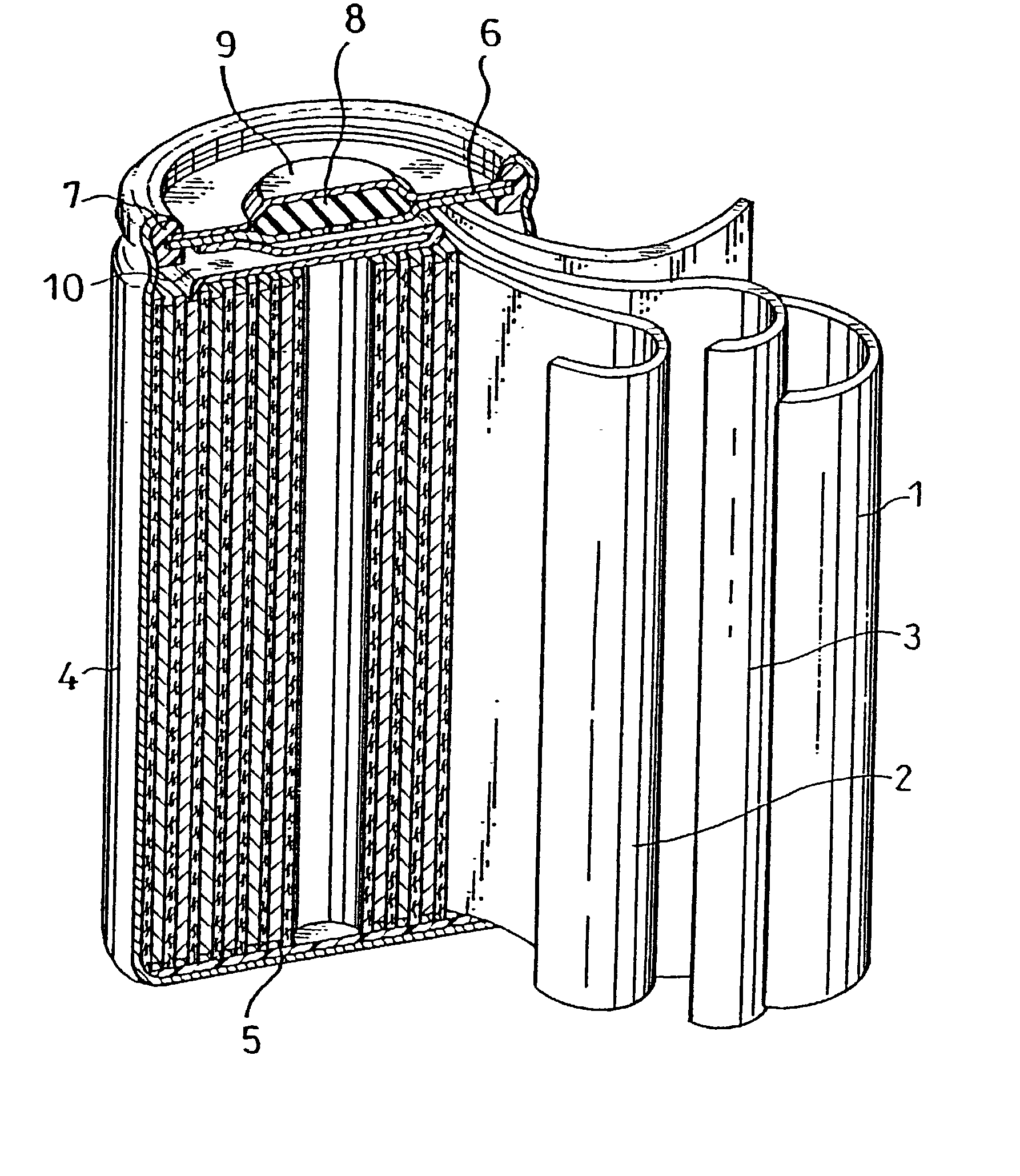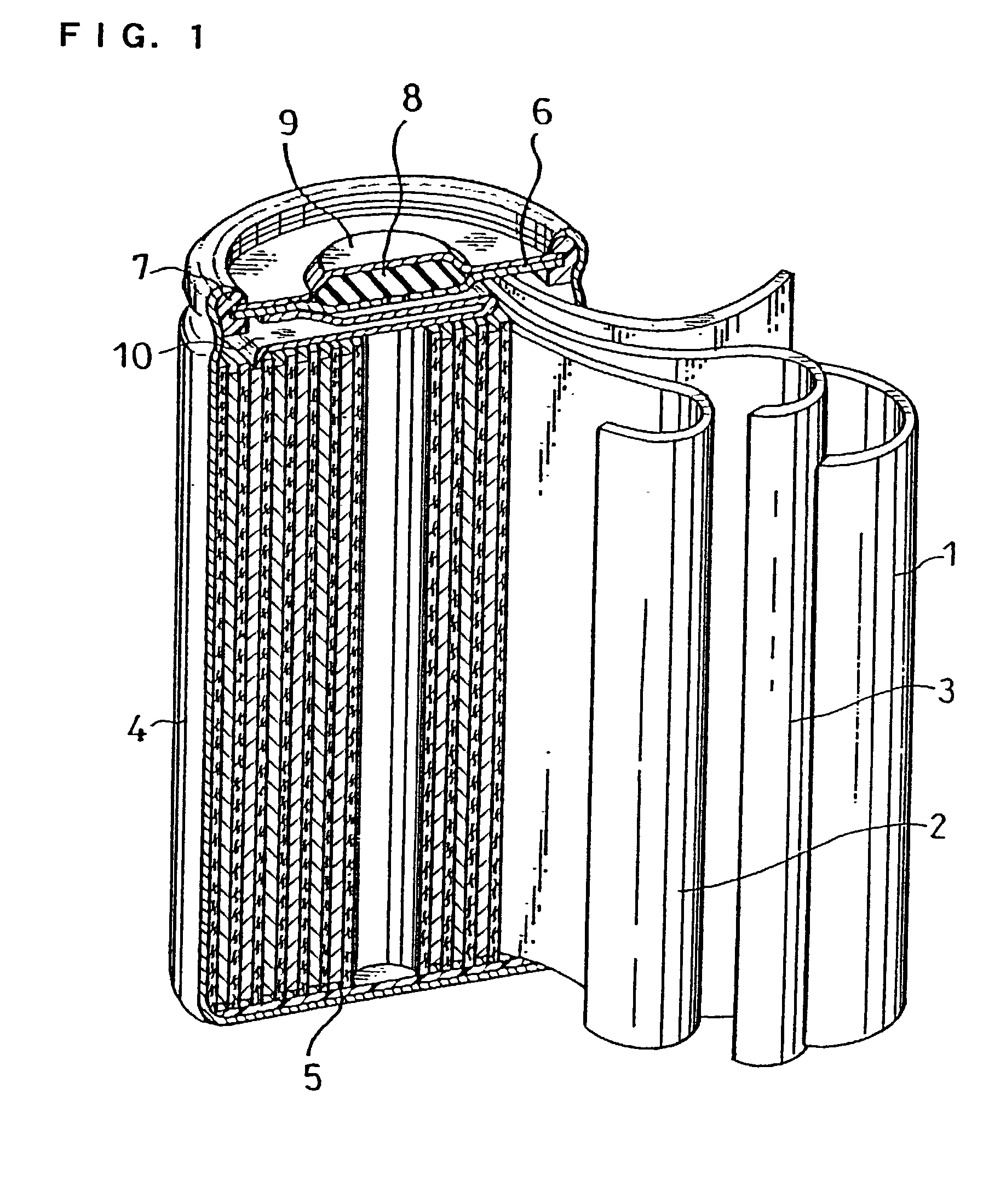Akali zinc secondary cell and method for preparation thereof
a secondary cell and zinc technology, applied in the direction of non-aqueous electrolyte cells, cell components, sustainable manufacturing/processing, etc., can solve the problems of high solubility, internal short circuit, and deterioration of separators, and achieve excellent maintenance of alkaline aqueous solutions, increase internal resistance, and relatively easy to promote corrosion of zin
- Summary
- Abstract
- Description
- Claims
- Application Information
AI Technical Summary
Benefits of technology
Problems solved by technology
Method used
Image
Examples
example 2
[0051] A sealed battery was produced in the same manner as in Example 1, except that fluorinated carbon (CF.sub.1.0) was used in place of polytetrafluoroethylene. This battery will be referred to as a battery C. The battery C was evaluated in the same manner as in Example 1. The result in the battery C was that: the discharge capacity measured at an initial stage of the charge / discharge cycles was approximately 1000 mAh; the cycle number at which the discharge capacity became 600 mAh was 260 on average.
example 3
[0052] 10 Gram of cross-linked type potassium polyacrylate, 125 g of an aqueous solution of potassium hydroxide having a specific gravity of 1.25 g / ml, 0.1 g of carboxymethyl cellulose and 6.75 g of a polytetrafluoroethylene powder were mixed and gelled. The obtained gel was applied on both faces of a micro-porous film made of polyethylene used in Comparative Example 1, and then dried. A separator layer having a thickness of 150 m was thus produced. Air permeability across this separator layer was about 10 ml / cm.sup.2.multidot.S at a pressure difference of 124 Pa. A sealed battery was produced in the same manner as in Example 1, except that the obtained separator layer was used. This battery will be referred to as a battery D. The battery D was evaluated in the same manner as in Example 1. The result in the battery D was that: the discharge capacity measured at an initial stage of the charge / discharge cycles was approximately 1000 mAh; the cycle number at which the discharge capacit...
example 4
[0053] 10 Gram of cross-linked type potassium polyacrylate, 125 g of an aqueous solution of potassium hydroxide having a specific gravity of 1.25 g / ml, 0.1 g of carboxymethyl cellulose and 6.75 g of a polytetrafluoroethylene powder were mixed and gelled. The obtained gel was applied on both faces of the positive electrode and the negative electrode used in Example 1, and then dried to a certain degree. The thickness of thus obtained separator layer after lamination of the positive electrode and the negative electrode was measured, and the thickness was about 140 .mu.m.
[0054] Using the positive electrode and the negative electrode having the obtained separator layer on both faces thereof, a sealed battery was produced in the same manner as in Example 1. This battery will be referred to as a battery E. The battery E was evaluated in the same manner as in Example 1. The result in the battery E was that: the discharge capacity measured at an initial stage of the charge / discharge cycles ...
PUM
| Property | Measurement | Unit |
|---|---|---|
| Pressure | aaaaa | aaaaa |
| Area | aaaaa | aaaaa |
| Thickness | aaaaa | aaaaa |
Abstract
Description
Claims
Application Information
 Login to View More
Login to View More - R&D
- Intellectual Property
- Life Sciences
- Materials
- Tech Scout
- Unparalleled Data Quality
- Higher Quality Content
- 60% Fewer Hallucinations
Browse by: Latest US Patents, China's latest patents, Technical Efficacy Thesaurus, Application Domain, Technology Topic, Popular Technical Reports.
© 2025 PatSnap. All rights reserved.Legal|Privacy policy|Modern Slavery Act Transparency Statement|Sitemap|About US| Contact US: help@patsnap.com



